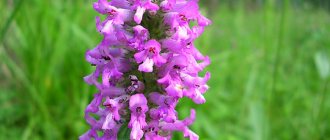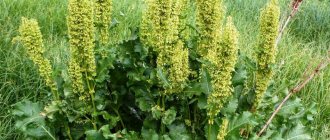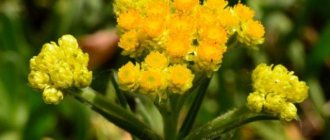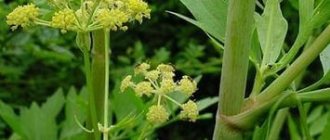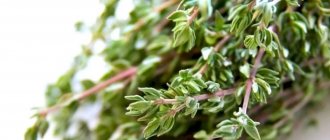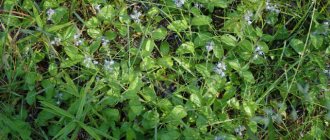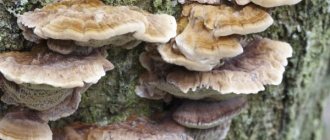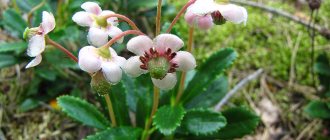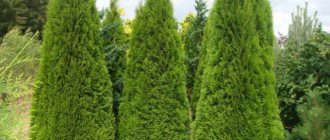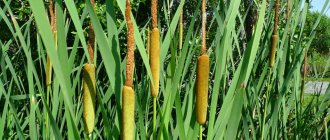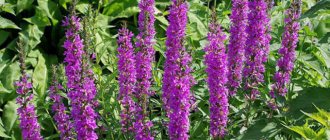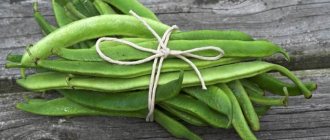Botanical description
The plant has a light aroma that allows it to remain unnoticeable. The botanical description of Angelica is as follows:
- Stem. Straight, the medicinal plant grows up to two meters in height. However, the stem part is not heavy, since it is hollow from the inside. The bare stem of angelica is cylindrical in shape, with a small number of brownish or reddish stripes. A coating in the form of mucus can be observed on the stem.
- Foliage. The pinnate leaf is divided into 2-3 segments. At the rhizome (below), the leaves form a rosette. They are characterized by elongated petioles.
- Flowers. A complex inflorescence is formed from the upper part of the plant. This is a voluminous umbrella, 200 mm in size. The dome consists of a large number of neat rays, at the ends of which you can see delicate, greenish flowers. The plant blooms throughout the summer season, exclusively for the 2nd year.
- Fruit. Around the last days of summer, flat winged stalks form from the flowers. They ripen and fall apart. Of these, approximately 0.5 kg of angelica seeds is poured onto the ground.
- Rhizome. The plant crop has a large root (up to 80 mm in diameter), growing vertically in depth. Many roots extend from the main rhizome. The root weighs about 300 grams.
Grass should not be collected. It is better to buy raw materials at a pharmacy. Externally, angelica officinalis can be confused with the poisonous forest plant crops veho and hemlock.
It is not recommended to collect angelica yourself. It is better to use a pharmacy drug. Externally, medicinal angelica is quite difficult to distinguish from poisonous vek and hemlock
Angelica officinalis
Another variety of angelica - angelica herb , or angelica officinalis - is also very common in the European part of the country. This biennial herbaceous plant is even larger in size.
Distinctive features : the stem is very thick (up to 5...6 cm at the bottom), round, hollow, often has a reddish tint, 1.5...2.5 meters high; leaves are very large, up to 80 cm in diameter, two- and three-pinnate with sharp-toothed edges, with long cylindrical petioles; the flowers are small, whitish-green with a yellow tint, united in a spherical multi-rayed umbrella, with a strong aroma, and are a good honey plant (up to 300 kg of honey per 1 ha). Flowering time – July – August.
In some areas, angelica is cultivated for a variety of uses: for beekeeping, the pharmaceutical industry, food and feed purposes.
Active ingredients
All parts of the plant culture include up to 1% esters. The essential oil contains the following monoterpenes:
- borneol;
- cymol;
- pinene;
- phellandrene.
Also contains terpenoids, coumarins:
- archangelcine;
- osthol;
- angelicin;
- ostenol;
- emperor;
- xanthotoxin;
- umbelliprenin;
- umbelliferone.
Legustilide and sedanolide are present in the air. Polyacetylene compounds have also been found:
- organic acids;
- falcarinol;
- bitter and tannins;
- falcarindiol;
- phytosterols, resins – 6%;
- coumarins and furocoumarins;
- wax;
- Sahara;
- pectins;
- carotene substances;
- starchy substances.
The fruits contain about 23% oil, the foliage contains ascorbic acid, Ca, P. Angelica honey contains vitamins, minerals, beneficial elements, 45% fructose, 37% glucose.
Use of angelica in medicine (video)
The value of a crop is determined by its chemical composition. The aerial part and rhizome contain:
- coumarins;
- tannins;
- resins;
- bitterness;
- essential and fatty oils;
- starch;
- wax;
- pectin;
- organic acids;
- Sahara;
- proteins;
- ascorbic acid.
For the presence of phytoestrogens - plant hormones whose properties are similar to those of women. Oil is extracted from the rhizome with a pleasant aroma and bitter taste, and decoctions and tinctures are produced. No wonder the product is widely used in Chinese medicine.
Pharmacological qualities
Angelica officinalis, the medicinal properties and contraindications of which will be useful for everyone to know, has a certain pharmacology. It is determined by the chemical composition of the herb:
- Galenic medicinal forms of the plant provide a healing effect for inflammation and spasms. It has a diuretic and diaphoretic effect.
- Studies have proven some sedative effect of medicinal angels.
- The most active ingredient is the essential oil of the plant, which penetrates the digestive system. Provides a slight irritant effect on the gastric lining, provoking an increase in the secretion of the organ, and removes spasms.
- When absorbed, angelica oil is partially secreted by the bronchi, increasing their secretion, providing an antimicrobial and antispasmodic effect on the respiratory system.
- The presence of organic acids in the consistency of the medicinal plant provokes increased sweating and urination.
Angelica officinalis has medicinal properties; it is actively used in alternative medicine and as an addition to standard methods of therapy.
The use of angelica officinalis in folk medicine
A large number of people, freely using plants to treat various diseases, believe that they are absolutely harmless. However, among medicinal plants there are potent, toxic and even poisonous ones. In addition, many people, especially older people, have several chronic diseases.
Therefore, in order for the treatment to be effective, when using it, one should take into account the beneficial and medicinal properties of angelica officinalis and the contraindications that it has, and this can only be done by a doctor. Based on this, before you start taking angelica officinalis preparations, consult a doctor, or better yet, a herbalist you trust. The information given below is for informational purposes only.
Cardiovascular diseases
In folk medicine, the beneficial and medicinal properties of angelica officinalis are used primarily as a tonic and improves the functioning of the cardiovascular system. Most often, a decoction of the roots of angelica officinalis is used for these purposes, but it is acceptable to replace it with a decoction of the whole plant.
A decoction of the roots is also drunk for atherosclerosis and vascular fragility.
For the head
The use of angelica officinalis for the treatment of certain head diseases has shown good results. Preparations of the roots (decoction, powder) are used for epilepsy, paralysis, and convulsions.
For preventive purposes, to prevent epilepsy attacks, take one inflorescence-umbrella of angelica, crushed into powder, every morning, washed down with a small amount of natural grape wine.
For ear pain, instill 2-3 drops of juice or 3-4 drops of angelica tincture into the sore ear, diluted with warm boiled water in a 1:1 ratio.
Colds and bronchopulmonary diseases
One of the indications of angelica officinalis is respiratory diseases. As an anti-inflammatory, expectorant, and diaphoretic, internal administration of a decoction of the roots is recommended for various colds, laryngitis, sore throat, cough, as well as bronchitis, pneumonia, etc.
Diseases of the gastrointestinal tract
The healing and beneficial properties of angelica officinalis and its use are effective, both as a preventive and health-improving agent, and for the treatment of diseases of the stomach and intestines. Preparations of the roots (decoction, tincture) improve appetite, activate the digestive glands, normalize the digestion process, enhance the secretory and motor functions of the intestines, thanks to their antibacterial effects, and suppress fermentation processes.
In official medicine, angelica officinalis is used to treat hypoacid gastritis (with low acidity of gastric juice), duodenitis, colitis, gastrointestinal colic and spasms, atony and bloating, flatulence, dyspepsia (indigestion), and diarrhea.
Taking root powder is also acceptable. The plant is taken both independently and in the form of herbal teas with angelica officinalis.
For the liver
Both official and traditional medicine uses angelica officinalis to treat the liver. The plant has choleretic properties and is prescribed for cholecystitis and cholelithiasis.
With biliary dyskinesia, as a result of using a decoction of angelica officinalis (roots), appetite improves, the feeling of fullness in the epigastric region, belching, and a tendency to nausea, vomiting, and abdominal pain disappear.
For the pancreas
How is Angelica officinalis useful for the pancreas? A decoction of the roots activates the functioning of the organ and increases the secretion of pancreatic juice. Thanks to the course of treatment, good results are achieved in inflammatory diseases of the pancreas, such as pancreatitis, etc.
Kidney and bladder diseases
Having a diuretic effect, angelica is a recognized drug for the treatment of diseases of the bladder and kidneys, such as urinary retention, urinary incontinence, ascites, etc.
For these purposes, both a decoction of the roots and powder are used. A good effect is achieved by using angelica in combination with other plants, for example, juniper and oats.
Also in Korean folk medicine, angelica officinalis fruits are recommended as an antispasmodic for kidney stones.
Oncological diseases
Angelica officinalis preparations are used for cancer. In the USSR, at the All-Union Institute of Medicinal Plants, it was practically proven that the substance furocoumarin in the plant has antitumor activity. Despite this, angelica has not received widespread use in official medicine for the treatment of this group of diseases.
As a folk remedy, angelica officinalis (decoction and infusion of the root) in complex therapy is recommended for the treatment of cancer of various locations, for example, cancer of the esophagus, stomach, pancreas, malignant tumors of the sigmoid and rectum, etc.
Nervous system diseases
The plant is widely used in both official and folk medicine for problems with the nervous system. What does angelica officinalis treat? The plant has a pronounced calming and tonic effect on the central nervous system and its action is reminiscent of medicinal valerian.
Tincture, decoction, infusion of angelica officinalis (roots) are taken for nervous exhaustion, neurasthenia, hysteria, anxiety, stress, insomnia, etc. For hysteria, you can also drink an infusion of leaves and a decoction of fruits.
Oral diseases
Angelica officinalis is a healer that helps get rid of toothache. To do this, apply a cotton swab dipped in juice or tincture to the sore tooth or gum.
Joint diseases
Angelica officinalis preparations are useful and effective for treating diseases of the joints and muscles. A course of internal administration of a decoction of the roots is carried out for rheumatism, gout, radiculitis, lumbago, lower back pain, muscle pain, etc. It is also acceptable to use angelica tincture and powder.
In folk medicine, there are recipes for angelica officinalis for external use. Using tincture, decoction, juice, lotions, compresses, and rubs are made. Baths have proven themselves well, for which you can use an infusion of the whole plant.
For neuralgia, it is recommended to rub the sore spot with alcohol tincture.
To achieve a stronger and longer-lasting effect, both internal and external use of plant preparations is carried out.
For the whole body
Is angelica officinalis useful or not for preventive purposes? Can it be taken to improve and strengthen the body as a whole? A course of root preparations stimulates blood circulation and improves immunity. The plant is recommended for radiation damage.
In addition, the medicinal properties of angelica officinalis and its use give good results for mental and physical fatigue. A decoction of the roots is prescribed to older people.
When to use
Angelica officinalis has multifaceted medicinal properties, they are due to the rich list of microelements in its composition. I usually use it for the following problems:
- biliary dyskinesia;
- kidney pathologies;
- belching;
- colitis;
- gastritis;
- duodenitis;
- colds;
- bronchitis;
- laryngitis;
- flatulence;
- influenza infection;
- pneumonia;
- otitis;
- toothache;
- migraine
- skin problems;
- gynecological pathologies;
- heart and vascular diseases.
Heart diseases
Pneumonia
Gynecological pathologies
Flatulence
Kidney pathologies
It is important for women to know that the plant can cause abortion. Therefore, it is contraindicated for pregnant women. The herb should not be used to terminate a pregnancy. This will cause severe intoxication and pathological effects on the psyche.
What is angelica useful for and what does it help with?
With regular use, angelica root:
- normalizes the nervous system and relieves insomnia;
- eliminates arrhythmia caused by stress and psychological tension;
- relieves inflammation and pain from rheumatism, arthritis and other joint ailments;
- helps get rid of shortness of breath;
- equalizes blood pressure and strengthens blood vessels;
- improves digestion and helps fight bloating and flatulence;
- has a beneficial effect on varicose veins and a tendency to thrombosis;
- normalizes appetite;
- strengthens immune resistance.
Angelica root extract can be found in many pharmaceutical preparations. The medicinal properties of the plant are officially recognized by traditional medicine.
Useful properties of angelica chinensis for women
Studying a photo of the angelica plant and its healing properties is useful for women. Products based on biennial dilate blood vessels, relieve pain during menstruation and improve general condition. The herb can be used during menopause; it balances hormonal levels and helps reduce the frequency of hot flashes.
Traditional medicine actively uses the properties of the angelica plant to treat gynecological diseases - mastopathy, endometriosis, uterine fibroids and polycystic ovary syndrome. With the help of decoctions and infusions based on medicinal herbs, you can restore the normal menstrual cycle. Angelica even helps with infertility if it is caused by poor blood supply to the pelvic organs and anemia.
Chinese angelica for women is used to treat gynecological inflammations and neoplasms
Medicinal properties of angelica chinensis root for men
The beneficial effect of angelica on hormonal levels also benefits the male body; the plant helps normalize the balance of testosterone and estrogen. Angelica restores proper lipid metabolism, strengthens the heart and blood vessels of the stronger sex, and serves as a prevention of heart attacks and strokes.
You can use biennial root to improve potency. The medicinal properties of angelica herb are good for treating infectious diseases of the genitourinary system.
Features of angelica
The plant crop is a honey plant. The product has an original shade (amber, chocolate), taste and aroma. Externally it looks like resin. Due to the slow crystallization process, it will not become sugary for a long time.
The taste is sharp, but not off-putting. The aftertaste is like caramel, the aroma is specific. Since the product contains a lot of vitamins and useful elements, ingestion has a positive effect on the cardiovascular system (cleaning the blood, lowering blood pressure, strengthening the immune system).
Main types
The culture includes approximately 116 species. But, mainly for medicinal purposes, only the following are used:
- Drug. Used only in medicine. This type provides great benefits.
- Forest. It grows up to 2 meters in height, the stem part is thick, and at the cut site you can see white sticky juice, similar to milk. This species is very aromatic and is harvested throughout the summer season.
- Bolotny. The plant is a meter tall, blooms almost the entire summer period, and is found more often in swampy places.
- Chinese. Low growing variety with dense foliage. Benefits the body and is used in a large number of drugs.
Chinese angelica
Swamp Angelica
Forest angelica
Medicinal Angelica
All these types are used and receive positive reviews.
Contraindications
Angelica officinalis, which has medicinal effects, has some limitations. The use of drugs containing the plant is not recommended in the following cases:
- if there is increased blood clotting;
- in case of thrombophlebitis;
- in the post-infarction period;
- for diabetes mellitus;
- during menstruation and uterine bleeding;
- during pregnancy and lactation;
- if there is sexual weakness.
Angelica - medicinal herb
Spreading
It is believed that plant culture originated in northern Eurasia. Basically, today it grows in the north, as well as in New Zealand. In the Russian Federation, angelica is quite common. About 80 different species grow in Russia. Melts everywhere, usually in temperate latitudes.
Many varieties grow in the Far East. More often, angelica grows close to water, in places where it is humid.
Angelica is not a fancy plant crop, so it can be cultivated even in the countryside.
Regions of distribution on the map of Russia
Contraindications of angelica herb
Despite the fact that angelica has found wide use in treatment and everyday life, experts recommend that people with hypersensitivity (individual intolerance) to essential oil refrain from using it. Allergic reactions usually occur when using multicomponent preparations that include angelica.
Pregnant women should be especially attentive to self-medication, so it is important to consult a doctor with any questions, otherwise the substances contained in angelica can cause a miscarriage. also prohibited to use the plant during breastfeeding and during heavy menstruation.
Since the product has a photosensitizing effect, it is not recommended to use angelica for those with thin and fair skin, especially before going outdoors.
An overdose can cause poisoning , paralyzing the central nervous system. If unpleasant symptoms appear, you should seek help from a medical facility.
How to use
The scope of application is multifaceted. The petioles and stem part are taken for making jam and marshmallows. You can make delicious candied fruits. A medicinal tincture is obtained from the rhizome. The foliage and roots can be preserved. In some liqueur drinks, infusions from the root are used.
To treat various pathologies in alternative medicine, all parts of the plant crop are used.
For food
Finely crushed angelica leaves are used as a spice. The rhizome is also used, as it is quite juicy and fleshy. The root is very aromatic. To make the spice, the rhizome is dried and ground to a powder. It can be added to a tea drink.
The culture is unique in that with such bright aromas it grows well in cold conditions. In some countries, grass is included in first courses. In Norway, the rhizome is excellent as an ingredient in confectionery, and in France it is used as a spice for drinks.
Angelica is considered a medicinal crop, has a bright and delicate aroma, has a spicy, pungent, sweetish taste and is a honey plant.
Angelika Dudnik
Medicinal use
Angelica seeds are used in the treatment of constipation and pathologies associated with problems removing fluid from the body. The foliage (usually externally) is taken to cure:
- rheumatic pathologies;
- gout;
- inflammatory processes in the oral cavity;
- otitis media;
- toothache;
- skin diseases.
Angelica has been used since ancient times for snake bites (removes poison) and for the treatment of old, neglected wounds.
What does the plant look like?
This plant is perennial, large, and can reach a height of up to 2.5 m. Its stem is straight and thick at the bottom. At the top of the angelica there is a branched part. The smooth stem is covered with a coating, bluish in tone, and is hollow inside.
The leaves at the root reach up to 80 cm in length. Their shape is triangular with two and three repetitions, short petioles. All leaf blades have sharp teeth along the edges. The foliage in the upper part is sessile, and in the central zone it is simple, smaller.
Angelica officinalis blooms with inflorescences resembling an umbrella, consisting of small flowers of yellow and green shades. Collected together, they form balls, the diameter of which reaches 20 cm, with internal rays from 20 to 40 pieces. The inflorescences have a dense pubescence and a double perianth, with an inconspicuous green calyx. The branched tops of the plant end with such flowers.
Flowering begins in June and lasts until August, after which fruits appear on the plant, white or yellow in color and elliptical in shape. They contain two seeds and are 0.9 cm long.
Honey: the value of the product and its use
Angelica honey product is one of the unique elite varieties produced by bees from the nectar of a famous medicinal plant crop. Therefore, it is not surprising that this honey is considered throughout the world to be one of the most useful and necessary for the quality functioning of the body.
Having inherited the standard benefits of the product and healing qualities, the angelica version of beekeeping has the highest biovalue.
This beekeeping product is considered throughout the world to be one of the most useful and necessary for the full functioning of the human body.
Angelica (Archangelica officinalis (Moench) Hoffm.)
1. Abrikosov Kh. N. et al. Angelica // Dictionary-reference book of the beekeeper / Comp. Fedosov N. F. M.: Selkhozgiz, 1955. P. 98.
2. Angelika // Encyclopedic Dictionary of Brockhaus and Efron: In 86 volumes (82 volumes and 4 additional). St. Petersburg, 1890-1907.
3. Atlas of areas and resources of medicinal plants of the USSR / Edited by P. S. Chikov. M.: GUTK Publishing House, 1980. 340 p.
4. Atlas of medicinal plants of the USSR / Ch. ed. N.V. Tsitsin. - M.: Medgiz. 1962. 702 p.
5. Biological encyclopedic dictionary (edited by M.S. Gilyarov). M. 1986. 820 p.
6. Botany. Encyclopedia “All the Plants of the World”: Trans. English Botanica / ed. D. Grigoriev and others - M.: Könemann, 2006 (Russian edition). pp. 94-95. 1020 pp.
7. Vermeulen N. Useful herbs. Illustrated Encyclopedia: Trans. from English B. N. Golovkina. M.: Labyrinth Press, 2002. P. 44. 320 p.
8. Voitkevich S. A. Essential oils for perfumery and aromatherapy. M.: Food industry, 1999. 282 p.
9. Gubanov I. A. et al. 618. Angelica archangelica L. (Archangelica officinalis Hoffm.) - Angelica officinalis, or Angelica // Illustrated guide to plants of Central Russia V 3 T. - M.: Scientific T. ed. KMK, Institute of Technology. issl., 2003. T. 2. Angiosperms (dicots: separate-petalled). P. 233.
10. Dudchenko L.G. et al. Spicy-aromatic and spicy-flavoring plants: Handbook / Responsible. ed. K. M. Sytnik. 1989. 304 p.
11. Angelica // Encyclopedic Dictionary of Brockhaus and Efron: In 86 volumes (82 volumes and 4 additional ones). St. Petersburg, 1890-1907.
12. Animals and plants. Illustrated encyclopedic dictionary. M.: Eksmo, 2007. pp. 376-377, 384-385. 1248 pp.
13. Elenevsky A.G., M.P. Solovyova, V.N. Tikhomirov // Botany. Systematics of higher or terrestrial plants. M. 2004. 420 p.
14. Illustrated guide to plants of the Leningrad region / Ed. A.L. Budantseva and G.P. Yakovleva - M.: Partnership of Scientific Publications KMK, 2006. P. 422. 799 p.
15. Mayevsky P.F. Flora of the central zone of the European part of Russia. — 10th corrected and supplemented. M.: Partnership of scientific publications KMK. 2006. P. 396. 600 p.
16. Maznev N.I. Encyclopedia of medicinal plants. — 3rd ed., rev. and additional M. 2004. pp. 59-60. 496 pp.
17. Mashanov V.I., Pokrovsky A.A. Spicy-aromatic plants. - M.: Agropromizdat, 1991. 287 p.
18. Neishtadt M. M. Identifier of plants of the central zone of the European part of the USSR. — 4th ed. - M.: Uchpedgiz, 1954. 256 p.
19. Novikov V. S. Popular atlas-identifier. Wild plants / V. S. Novikov, I. A. Gubanov. — 5th ed. M.: Bustard, 2008. pp. 288-289. 415 pp.
20. Nikolaychuk L.V., Zhigar M.P. Healing plants: Medicinal properties. Culinary recipes. Application in cosmetics. 2nd ed., Kharkov. 1992. pp. 27-29. 239 p.
21. Turova A. D., Sapozhnikova E. N. Medicinal plants of the USSR and their application. 4th ed., M.: Medicine. 1984. 304 p.
22. Universal encyclopedia of medicinal plants / comp. I. N. Putyrsky, V. N. Prokhorov. — M.: Machaon. 2000. pp. 115-116.
Oil from the plant: methods of application
Angelica oil, like any other esters, can only be used externally. Ingestion is prohibited. The methods for using the oil are as follows:
- To normalize the functioning of the digestive system. Connect 2-3 drops. angelica oil and 1 tsp olive, almond or coconut squeeze. The product is applied to the belly, rubbing in a circle.
- Removing fluids, toxic substances and salts from the body. Apply the ether to the skin in its pure form, or by mixing it with the main aroma oil. Treat swollen and cellulite areas.
- Apply for arthritis and rheumatic pain.
- For the central nervous system. Add 2-3 drops. aroma oils into a diffuser, or into a body cream and rub over the skin.
- As an expectorant. A few drops of aroma oil are added to the hot water of the inhaler and standard inhalations are performed.
- The ether is also used for skincare procedures. Oil is added to face cream, body care products, and shower gels. Apply in the standard way.
Angelica oil
Application
To normalize digestion (accumulation of gases, fermentation, spasms), for colds, cholecystitis and gynecological inflammation, an infusion of angelica herb is used:
- You need to take roots, leaves, seeds (1 tablespoon each).
- Grind everything.
- Boil three glasses of clean water and pour in the mixture.
- Leave for six hours, then strain.
- Drink ½ glass three times during the day.
For some diseases, for example, colitis, gastritis (with high acidity), problems with the respiratory tract and heart, you can prepare a tincture from angelica roots:
- Place two hundred grams of root (dried and crushed) in a container;
- Pour in 0.5 liters of vodka (quality);
- Leave for 14 days in a sunny place.
- After straining and drinking three times a day (20 drops each).
You can rub the joints with the tincture.
For problems with the gallbladder and liver, bronchitis, and colds, use angelica decoction:
- The crushed dried root (in the amount of three tablespoons) is poured with boiling water (two hundred milliliters).
- Heat for half an hour in a water bath.
- Cool and then strain.
- Add boiled water to a volume of 250 ml.
- Drink 130 milliliters of hot decoction in the morning and evening after meals.
Angelica oil can only be used for external procedures:
- Treat swollen areas and where there is cellulite (removes toxins);
- Rub in for pain of rheumatic origin and arthritis.
For normal functioning of the digestive system, mix two or three drops with a teaspoon of coconut, almond or olive oil. Apply to the stomach and rub in circular movements.
Growing
Well-lit areas or semi-shaded areas are excellent for cultivating angelica. The soil should be enriched, well-moistened and permeable.
Prepare the plot right before sowing the seeds; to do this, dig up the garden and add compost fertilizer. After this, the soil is leveled.
Landing
Angelica is sown in the garden in the fall before winter. Before the onset of spring, the seed will undergo natural stratification. They sow thickly, since the germination rate of the crop is low. If a lot of sprouts sprout in the spring, then they need to be planted, adhering to the 600x400 or 600x300 mm pattern. There is no need to cover crops for the winter.
If sowing of seed is planned for spring, stratification will be required. To do this, the seeds are sent to the refrigerator on the vegetable shelf, where they should lie all winter.
Before planting, you need to combine the seeds with wet sand and pour them into boxes. Usually, with the arrival of spring, there are few germinating seeds left.
Angelica is sown in the garden in the fall before winter
Care
When the sprouts sprout, it is necessary to add mulch (moss) to the surface of the bed, which will have a positive effect on the final harvest.
It is not difficult to grow angelica in the countryside; to do this, you need to carry out intensive watering during drought, weed the weeds, fertilize it with minerals twice a season, often loosen the soil surface around the angelica, and also provide protection from parasites and diseases.
Reproduction
Angelica reproduces only from seed. Grows well among mature bushes of the same species. Blooms in the second year of life.
When mowing flowering stems, secondary formation of generative shoots was observed in the same year, while their re-development the following year never occurs.
What is angelica, where and how it grows, photo of the plant and description
Angelica (angelica officinalis) is listed in the botanical register as Angelica archangelica. It is a biennial or perennial herb that reaches two meters or more in height. Favorite places of growth are swampy lowlands, banks of rivers, ponds and lakes, streams, ditches, and marshy meadows. Petiolate leaves extend from a thick, empty stem inside; the rhizome is thick and fleshy. Only two-year-old grass blooms, the umbrella inflorescences of which are clearly visible among other grass.
The pulp of the root and other parts of angelica have a characteristic smell of celery (after all, another name for umbrella plants is celery) and a pleasant taste.
Medicinal (pharmaceutical) value is provided by raw materials collected at the end of the first year of angelica’s life (in autumn) and at the beginning of the next season (in spring). The beneficial properties of the plant are used both in cooking and in folk medicine. Almost all parts of angelica are suitable for this:
- Rhizome.
- Young leaves.
- Seeds.
The fruits (seeds) begin to ripen in July and become fully ripe in early autumn.
Angelica is rich in medicinal substances:
- Essential oil.
- Natural antioxidants (valeric and other acids).
- With resins.
- Pectins.
- Tannins.
- Carotene.
- Sugars, etc.
Scientists also found calcium, phosphorus and other micro- and macroelements in it.
If a person does not know what real angelica looks like, it is better not to collect this medicinal and culinary raw material. The genus of umbrella plants is very numerous, and among the marsh plants there are many, if not doubles, then very similar to angelica. You need to learn to distinguish them - there are even short video lectures on this subject.
Plants similar to angelica officinalis, or its close but wild relatives, can be either useless for treatment or deadly for humans. Among them, the most dangerous is angelica. In different regions it is called cat parsley, omega, poisonous hemlock. But perhaps its most famous name is hemlock. And it is associated with the death of the ancient Greek philosopher Socrates, who, according to legend, drank a cup of the juice of this plant at the verdict of his fellow citizens and died. Although botanists are very skeptical about this interpretation of events, since swamp hemlock does not grow in Greece. Most likely it was a spotted hemlock.
Angelica (in scientific language Angelica silvestris) is a close variety of medicinal angelica, but it is not used in folk medicine.
Angelica Chinese (Angelica sinensis) is not only a valuable medicinal product, but also an excellent spice. Therefore, in ancient Chinese treatises it is recommended to eat it to combat infertility and painful menstruation, and other diseases.
Diseases and pests
Sometimes angelica is affected by fungi, such as powdery mildew or rust. Professionals do not advise spraying plantings with chemicals, as angelica accumulates poisons. Ideal prevention solution:
- Follow the rules of crop rotation.
- Fertilize with minerals with a minimum amount of nitrogenous elements.
- Weed regularly.
Experts do not recommend spraying bushes with chemicals, as they are characterized by their ability to accumulate toxic substances.
Angelica is distinguished by its resistance to drought, and the most dangerous parasite is the spider mite, which loves dry weather. In order to destroy the pest, angelica should be sprayed with tobacco infusion. To create it, mix 3 liters of water and 200 grams of tobacco or shag, after 24 hours the infusion is ready.
The filtered product is mixed with 50 mg of liquid soap to increase its stickiness, and the plantings and soil can be treated.
Chemical composition
Angelica herb has a high content of proteins and fats. It may contain 20-25% sugars.
The essential oil prepared from this plant contains valeric acid. Vitamin C is also present in the composition. The content of angelic acid is 0.3%.
The fruit contains approximately 15% fatty oils. There are also various derivative substances - coumarin, imperatorin and essential oils.
This herb is also rich in iron salts. The rhizomes contain amino acids, including essential ones.
Collection of sweet clover
Usually the rhizome of angelica is used for medicinal purposes, only sometimes leaves and seeds are used. For shrubs of the first year of life, the rhizome is harvested in the fall, and for sweet clover of the second year of life, in the spring.
The root must be dug out of the ground, the remaining soil must be removed and the stems must be cut off. Then inspect the root, discard those roots that have been chewed by a mole or mouse, because they are no longer healing. Then the rhizome is washed in cold water and cut lengthwise.
Pieces of raw materials are laid in 1 layer on a wire rack, paper or thin cloth for drying. The roots are placed in a shady place outside. In order to dry in the oven, the stove is heated to 35–40 °C.
Collection of sweet clover
Signs of quality raw materials
To obtain high-quality medicinal raw materials that have the described beneficial properties, you need to collect them correctly. The main thing is not to make a mistake, since angelica is similar to some poisonous plants from this family. Particular attention is paid to the integrity of the shoots, leaves and other parts - even the slightest damage is unacceptable, otherwise the herb will be useless medicinally.
Angelica is harvested in September or October. First-year specimens are selected. But the grass in the second year of growth is collected in early spring - in March-April.
The roots are dug up and the soil is shaken off, then the upper part with the leaves is cut off. After this, the rhizome is washed with cold water, cut lengthwise and hung in the fresh air to dry or laid out in any place with good ventilation. The thickness of the layout should not exceed 7–8 cm. You can use special dryers where the temperature is set to no more than 40 °C.
For the same purpose, the leaves are plucked during flowering and dried in room conditions. Seed collection begins when the fruits are fully ripe. They do this - they tie the umbrellas of the inflorescences together, dry them and then remove the seeds. The finished raw materials are placed in cardboard containers or canvas bags and stored in a place where there is no access to moisture. It does not lose its properties for 2 years.
Dried angelica roots have a pleasant aroma and spicy taste.
Video: how to prepare angelica root
Recipes for various diseases
Since ancient times, angelica has been considered a healing crop. Angelica normalizes blood flow and has a positive effect on the immune system. The roots, which have a pleasant, fresh aroma, are used in recipes. The remaining parts of angelica are also used.
Infusion
Angelica officinalis infusion is used for baths. 100 grams of raw materials are poured into 3 liters of boiling water, allowed to stand for 4 hours. Strain into a bath of water at 38 °C. Swim at night. After the bath, drink a tea drink with valerian.
Remedy from all parts
The healing remedy is made from the rhizome 1 tbsp, a spoonful of seeds, leaves (chopped), the same amount of water - 3 cups. All ingredients are crushed and mixed. Brew with boiling water. Allow the product to stand for 6 hours. Filter and can be used.
Tincture
To create a tincture, take 1 part of the rhizome, pour 10 parts of vodka and let it sit for a week and a half. The tincture is filtered and consumed 50 drops before meals.
Angelica vodka
This is another type of angelica tincture. Helps with problems of the central nervous system, treatment of gastrointestinal and respiratory pathologies. You will need 100 grams of rhizomes, a liter of vodka. The raw materials are crushed and filled with vodka. Leave in a dark place for 3 weeks. Shake once every 7 days and be sure to filter.
Decoction
To create a decoction, place 3 tablespoons of angelica in an enamel-coated pan, brew 250 ml of boiling water, keep on low heat for half an hour, cool for 10 minutes and filter. Consume half a glass in a warm state three times a day when they eat.
Dosage forms
Root decoction
10 gr. (3 tbsp) pour 250 ml of angelica officinalis raw material. water. Bring to a boil and simmer over low heat for half an hour. Remove from heat, cover, wrap and leave until warm. Strain, squeeze out the raw materials. Bring the resulting decoction to its original volume using boiled water. Store in a cool place, such as a refrigerator, for no more than two days.
Take half a glass warm 2-3 times a day after meals.
Herbal decoction
Prepare in the same way as a decoction of roots at the rate of 10 g. crushed part of the leaf of angelica officinalis per 250 ml. water. Boil for 5 minutes, leave for two hours.
Take 0.25 tbsp. 2-3 times a day before meals.
Tincture
Place crushed angelica roots in a glass container (preferably dark glass), pour 70% alcohol in a ratio of 1:10. Close the container tightly with a lid and leave in a dark place at room temperature for 10-14 days, remembering to shake periodically. Strain, squeeze out the raw materials.
Take 20-30 drops, diluted in 30-50 ml. water, three times a day, half an hour before meals or an hour after meals.
Powder
Dry roots and rhizomes are ground into powder in any convenient way, for example, using a coffee grinder.
Single dosage - how much will fit on the tip of a knife. Take 2-3 times a day with a small amount of boiled water.
